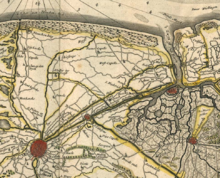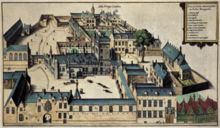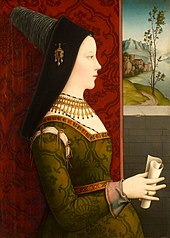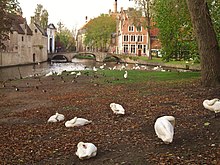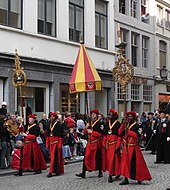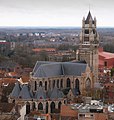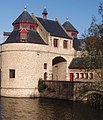Bruges
| Bruges | ||
|---|---|---|

|

|
|
|
|
||
| State : |
|
|
| Region : | Flanders | |
| Province : | West Flanders | |
| District : | Bruges | |
| Coordinates : | 51 ° 13 ' N , 3 ° 13' E | |
| Area : | 138.4 km² | |
| Residents: | 118,325 (Jan 1, 2019) | |
| Population density: | 855 inhabitants per km² | |
| Height: | 2 m | |
| Post Code: | 8000 (Bruges, Koolkerke) 8200 (Sint-Andries, Sint-Michiels) 8310 (Assebroek, Sint-Kruis) 8380 (Dudzele, Lissewege) |
|
| Prefix: | 050 | |
| Mayor: | Dirk De fauw | |
Local government address : |
Burg 12 8000 Brugge |
|
| Website: | www.brugge.be | |
Bruges ( Dutch Brugge , French Bruges ) is the capital and with 118,325 inhabitants (as of January 1, 2019) the largest city in the province of West Flanders in Belgium . In addition, Bruges is the bishopric of the diocese of Bruges .
In the late Middle Ages , the Dutch region around Bruges was one of the centers of the textile industry and long-distance trade in Europe and thus one of the birthplaces of early capitalism . The Dukes of Burgundy temporarily resided in the city , under whose rule Bruges became one of the economically and culturally richest cities in Europe at that time.
The old town is surrounded by ramparts with windmills and canals. Since Bruges was never destroyed by war or large-scale fires, the medieval cityscape and historical buildings are very well preserved. The city can be explored both on foot and by boat. The canals that run through the city are called Reien by the locals, after the Reie river , which was completely canalized in the Middle Ages and connected Bruges directly to the North Sea.
The medieval city center was declared a World Heritage Site by UNESCO in 2000 . In 2002 Bruges was European Capital of Culture .
Bruges has an important seaport in the district of Zeebrugge and is home to the College of Europe .
Surname
An origin from a West Germanic word for "bridge" is likely. Several similar words are mentioned in the ancient documents in different Germanic languages, e.g. B. Old English bryċġ > bridge , Old Saxon bruggia , Old High German brucca , Old Norse bryggja , which probably all go back to the Germanic * bruʒjō .
Districts
- Downtown Bruges, Sint-Pieters and Sint-Jozef (I)
- Koolkerke (II)
- Sint-Andries (III)
- Sint-Michiels (IV)
- Assebroek (V)
- Sint-Kruis (VI)
- Dudzele (VII)
- Lissewege , Zeebrugge ( Seebrugge ) and Zwankendamme (VIII)
history
Prehistory and foundation
Already in the 2nd and 3rd centuries there was a Gallo-Roman settlement in the area of Bruges . Its inhabitants were not only farmers but also traders who maintained contacts with Roman Britain and the rest of Gaul .
In the middle of the 9th century, Baldwin I built a fortress on the place still known today as the castle to protect the coast from attacks by the Vikings . Bruges received city rights in 1128.
European trading metropolis (13th - 15th centuries)
In the Middle Ages , the city was directly connected to the sea via a branch of the North Sea , the Zwin , which arose as a result of a storm surge in 1134 , and the canalized river Reie and was thus able to participate in long-distance trade . The first trade fair took place in Bruges around 1200 . Wool from England for cloth production , spices and brocade from Italy, furs and woods from Russia, lambskins from Spain, wine from France and tapestries from Flanders were traded - the region around Bruges became a center for textile production and textile finishing . In the branching trade network of Flanders, Antwerp was the second most important long-distance trading center after Bruges, while Ghent and Ypres were regional market places. All foreigners left Bruges for the six-week Pentecost market to trade in Antwerp .
Merchants from the cities on the Rhine and from the Hanseatic cities of Lübeck and Hamburg also came to Bruges. The Hanseatic built on the North Sea near the Steelyard in London and the Bryggen in Bergen , a Hansekontor in Bruges and was so impressed with the markets outside their economic space connected. Bruges developed into an important staple market . In 1253 the Countess of Flanders Margaret II granted the Hanse merchants various trading privileges . More than 500 surviving letters and ten trading books by the Lübeck Hanseatic merchant Hildebrand Veckinchusen , who lived in Bruges at the time, provide information about the business practice and life of merchants in the late Middle Ages . Of the meeting house of the Bruges Hansekontor on the Osterlingenplein , the house of the Easterlings , only the right part, used as a hotel, remains. German merchants were referred to as Easterlings - "those who came from the East".
In the Spore Battle (July 11, 1302) near Kortrijk , an army consisting largely of citizen militias successfully defended the independence of the Flemish against France's claim to power, after the Bruges early mass on May 18, 1302 . The battle, like the battle of revenge at Mons-en-Pévèle (August 18, 1304), was a pre-conflict of the Hundred Years War (1337-1457) between England and France, whose economic background from the Flemish point of view was the fight for Flanders as the center of the European cloth industry .
In the first phase of the Hundred Years War , the English King Edward III. The Flemish cities - including Bruges as the most important long-distance trading center - were under pressure through a ban on the export of English sheep's wool, forcing them to cooperate. Ludwig I of Flanders had the boycott by supporting the claim of Philip VI. summoned to the French throne. With the naval battle of Sluis (June 24, 1340) the first major direct confrontation between the warring parties occurred. With the victory of the English fleet, the French dominance in the English Channel was finally broken and the north-eastern border of France was seriously endangered. Because of its strategically important location, Bruges suburb of Sluis was expanded into a fortress town in 1382 and a castle was built there from 1385 on behalf of the Burgundian Duke Philip II .
For the first time in Bruges, English merchants have had 1359 trading privileges. Founded in 1407 in England with London-based trading company Company of Merchant Adventurers - one of the most important English cloth trade companies of the late Middle Ages - was approved by the English crown , the monopoly granted to the export of untreated cloth to the Netherlands. The Company of Merchant Adventurers opened its first branch in Bruges . In 1446, Duke Philip III gave her better conditions . and she moved her Dutch headquarters to Antwerp.
On previous Oude Beursplein ( dt. Age stock exchange trade offices of the Italian maritime cities) were Genoa , Florence and Venice and was built in 1246 the house of the merchant family Van der Beurze , the first stock exchange in the world. Domestic and foreign merchants met there regularly and conducted trade and exchange transactions . The Dutch word beurs as a name for such trading centers was derived from the family name of the merchants and was adopted accordingly in other European languages.
In 1369 Bruges became part of the Duchy of Burgundy and the seat of the Burgundian Dukes . Merchants from all over Europe came to the city to do business. A district with trading establishments was created around Jan van Eyckplatz . Many of the merchant ships docked here, while the Spanish merchants had their port at Spaanse Loskaai .
Court and rule of the Dukes of Burgundy (14th - 15th centuries)
Under the rule of the Dukes of Burgundy , Bruges developed into one of the richest cities in Europe, both economically and culturally. The painting Virgin and Child under Angels, ascribed to the master of the André Madonna , and the same motif, Virgin and Child with Four Angels by Gerard David, show a cityscape from this period as a background.
In densely populated and urbanized Flanders, with its economy dominated by textile production and trade, politics was dominated by the cities, in other territories of Burgundy by the nobility. At the courtyard and in the south of Burgundy they spoke French , to the north but still dutch . The dukes of Burgundy and their court traveled around their territory and were not tied to any fixed location. During their stays in Bruges, she and her court resided in the prince's court . In 1426 the court still had 230 people, by 1474 their number rose to around 600, not including the numerous Leibbogen people . The court, who received pensions and salaries for his services, represented the respective duke; Festivals, knight tournaments, entries into cities and the cult of the dead demonstrated its rank, power, wealth and merits.
“The whole court was luxurious, the house treasure and the library were full of treasures, and the court ceremony was geared towards a god-like exaggeration of the ruler. In the self-image of the noble-knightly world of Burgundy and his court, hunting trips and tournaments were just as firmly anchored as class-appropriate amusements during the day, as were the well-staged evening dance and mask festivals accompanied by great musicians. "
Struggle for the Burgundian heritage (14th-15th centuries)

After the death of Charles the Bold in the Battle of Nancy (1477), the Duchy of Burgundy disintegrated in a short time in the battle for the Burgundian inheritance between Maximilian von Habsburg and France .
In 1477, Charles the Bold's heir, Maria of Burgundy, married the son of the Roman-German Emperor Friedrich III. Maximilian, to whom she was engaged since 1475. The French King Louis XI. Maria refused the offered marriage with his son, the only seven-year-old Dauphin Karl .
Through this marriage Maximilian became iure uxoris Duke of Burgundy and thus also ruler of Flanders , which thus became part of the Habsburg family . In the War of the Burgundian Succession (1477–1493) it was Maximilian's declared aim to recapture the entire Duchy of Burgundy, which was largely occupied by France after the death of Charles the Bold, and to secure his rule in the Burgundian Netherlands .
After a riding accident during a falcon hunt near Bruges, Maria died on March 27, 1482 as a result of her injuries. Fifteen thousand people are said to have paid their last respects to her during the elaborately staged burial in the Church of Our Lady in Bruges. Before she died, Maria declared her only four-year-old son, Philipp , who was born in Bruges, to be Duke and thus also the heir of the Duchy of Burgundy. Via Philipp and his two-year-old sister Margarete , the estates - which politically did not include the sovereign, but the economically and thus also politically powerful cities of Flanders - de facto exercised the guardianship . The children of Maria and Maximilian were recognized as heirs by the estates, but not the guardianship of their father Maximilian and his reign over the Burgundian Netherlands, which Maria decreed in her will .
After the Peace of Arras (1482) , Maximilian wanted above all to ensure the guardianship of his son Philip in order to legitimize his custodial government over his Burgundian legacy - initially in the Burgundian Netherlands. The northern provinces supported Maximilian's reign, while the south of the Netherlands only accepted the Regency Council formed by the rebellious provinces of Geldern, Flanders and Brabant and refused to surrender his son who was held in Ghent . With the support of France, the rich Flemish cities of Ypres , Ghent and Bruges , in particular, opposed the rule of the Habsburgs. The powerful city of Ghent fell away from him and the guilds of Bruges also rebelled.
The uprisings in the Dutch provinces and cities were finally put down by Maximilian and the succession disputes with the French crown finally ended after the Treaty of Senlis (1493) was signed.
Maximilian's Captivity in Bruges (1488)
The city of Bruges did not shy away from imprisoning Maximilian - from 1486 also Roman-German king - from January to May 1488 in the Craenburg house on the Grote Markt when he wanted to introduce new taxes. His father first had to assemble an army to force his son's release. Maximilian's advisor Pierre Lanchal, also known as Lankhals , and members of the city administration suspected of treason were tortured in front of Maximilian's eyes in the Grote Markt and finally beheaded. A legend claims that after his release Maximilian condemned Bruges - to atone for this affront and to remind forever of this disgrace - to keep swans - "long necks" - on the Minnewater forever; the swans are still represented there in large numbers today.
Decline (16th - 19th centuries)
At the end of the 15th century the Zwin silted up. Bruges was thus cut off from the North Sea. The Burgundian court withdrew from the city and Maximilian restricted the rights of the city. This had to give up its leading position in Flanders to Antwerp , which is connected to the North Sea via the sand-free Scheldt .
Bruges became impoverished and came under Spanish rule from 1524 to 1713. The Huguenot Wars further contributed to the decline. The city has enjoyed fishing privileges for Bruges since 1666 . The city stood still for centuries; one after the other, the Imperial House of Habsburg (1713 to 1795), France (1795 to 1815) and the Netherlands (until 1830) ruled over Bruges.
Modern times (from 1830)
After 1830 Flanders and with it Bruges became part of the new Kingdom of Belgium. The city had practically no part in the industrialization that began in the 19th century . It wasn't until the late 19th century that Bruges received some attention as a city of culture when the writer Georges Rodenbach described the city in his novel Bruges la Morte . When a connection to the Zeebrugge seaport was created in 1907 , Bruges received new economic prospects. Since 1949, Bruges has hosted the College of Europe as a renowned European university, and in 1960 the city was awarded the European Prize for its outstanding efforts to promote European integration. Today Bruges benefits from the centuries-old stagnation, as the medieval city center has remained undeveloped and forms the basis for tourism.
Culture and sights
Holy Blood Procession
In the Holy Blood Basilica in the center of Bruges, the "ampoule with the blood of Christ ", venerated by Catholics as one of the most important relics in Europe, is kept. The relic has been carried through the city on Ascension Day during the Holy Blood procession since 1291 . The Bruges-born count and crusader Dietrich von Alsace is said to have received the relic for brave deeds during the Second Crusade in Jerusalem . In 2009, the Holy Blood Procession was added to the Representative List of the Intangible Cultural Heritage of Humanity .
Festival of ancient music
Since 1964, the Musica Antiqua Brugge Festival (today MAFestival, an abbreviation of Musica Antiqua Festival , also known as Festival van Vlaanderen Brugge ), one of the most important early music festivals, has been held every year at the beginning of August .
Attractions
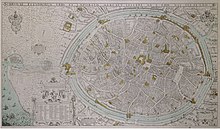
- Grote Markt - The central large market in Bruges was still accessible by boat in the Middle Ages. On the east side of the market, goods, especially fabrics,could be stored and traded in the dryin thelarge cloth hall calledthe water hall . This water hall was built from 1294 and demolished in 1787. Since then, the Provinciaal Hof , the post office and thebuilding plannedas the governor's residence have been located here.
- Bruges Belfry - The belfry is 83 m high and is integrated into the halls on the central market square of Bruges (Grote Markt) . Like this one, it was built in the 13th and 14th centuries. In the late Middle Ages, the tower towering over all the buildings in the city demonstrated the power of the self-confident rich bourgeoisie and served as a fire watch. Still (as of the end of the 2010s) no new building is allowed to tower over it.
- Provinciaal Hof - The building was built in the neo-Gothic style after the neo-classical building burned down on February 20, 1878. The Provinciaal Hof is the seat of government of the Province of West Flanders .
- Holy Blood Basilica is the oldest building in the architecturally interesting square of Bruges , the castle located in the immediate vicinity of the market . The double church consists of the St. Blaise Chapel as a lower church and an upper church. The sacred building is the repository of one of the most important relics in Europe - an ampoule with the blood of Christ .
- town hall
- Rozenhoedkaai
- De Halve Maan - is the oldest city brewery in Bruges, which opened in 1546. The brewery has been run as a family business since 1856, in the sixth generation in the 2010s. The brewery's specialty beers are Brugse Zot and Staffe Hendrik . The brewery and the attached beer museum can be visited.
- Minnewater
- St. Salvator Cathedral
- Church of Our Lady with the Bruges Madonna by Michelangelo , resting place of Charles the Bold and his daughter Maria
- Bruges Beguinage
- City gates: Gentpoort. Kruispoort , Smedenpoort and Ezelpoort
- Bruges Reien - Bruges canals were initially named after the Reie river , which used to flow through the city. Its name was derived from the Celtic word Rogia for holy water ; the Celts viewed rivers and wells as divine beings. Because of the many canals and arched bridges, Bruges is also called the Venice of the North .
- Old Sankt-Jans-Hospital (Oud Sint-Janshospitaal) - The former hospital was founded in the second half of the 12th century. Since 1188 pilgrims , travelers and the sick have been cared for by nuns here. In Sankt-Jans there is not only the Hospital Museum but also the Memlingmuseum (Memling in Sint-Jan) .
- Windmills at the Kruispoort - In the Middle Ages, Bruges was in fact a fortress surrounded by walls and moats. The city was only accessible through fortified city gates. On one of the ramparts, near the Kruispoort city gate , four of the once 20 windmills have been preserved. Two of these windmills are still fully functional.
- Gruuthusemuseum
Museums
The city museums in Bruges are divided into the categories of Fine Arts (from the 15th to the 21st century), Bruggemuseum (collective name for eleven historical museums) and Hospitaalmuseum (hospital museums ).
The two museums of fine arts are the Groeninge Museum , with a collection of Flemish primitives as well as paintings and sculptures from the Renaissance , Baroque , Classicism and Expressionism, and the Arentshaus .
Bruggemuseum contains the archeology museum , the Gentpoort , the belfry , the town hall , the Bruges Freiamt , the Gruuthusemuseum , the Liebfrauenkirche , the local history museum , the Koelewei mill , the Sint-Janshuis mill and the Guido-Gezelle museum .
The two hospital museums are the Old Sankt-Jans-Hospital (Oud Sint-Janshospitaal) with the Memlingmuseum (Memling in Sint-Jan) and Our Lady of Potterie . In Memlingmuseum the Bruges painter are among other works Hans Memling shown, including Ursula Shrine (before 1489), the martyrdom of Saint Ursula represents and the triptych with the mystical marriage of Saint Catherine on the middle panel (1479).
Private museums in Bruges are the Historium that Begin house , the Brewery Museum , the Beer Museum , the Diamond Museum , the Chocolate Museum Choco-Story , the Frietmuseum (in the late Middle Ages trading branch of the Italian seaside city of Genoa ), the lamp museum Lumina Domestica , the English monastery , the Saints blood Basilica , the court Bladelin , the Jerusalem Church , Museum-Gallery Xpo: Salvador Dalí , the lace center , the St. George's Archers , the St. Sebastian's Archers , the St. Salvator's Cathedral , the St. Trudo Abbey , the Beisbroek Observatory and the Ter Doest Monastery in Lissewege .
Theaters, concert halls, cinemas
Bruges has various theaters and concert halls. The most important are the Concertgebouw (“Concert Building”), which was newly built for “Bruges 2002 - European Capital of Culture” - the residence of the Anima Eterna Brugge orchestra -, the Stadsschouwburg, Biekorf, De Dijk, De Werf, the Magdalenazaal, Het Entrepot and the Joseph Ryelandtzaal.
The three cinemas in Bruges are Cinema Lumière for non-commercial films, Cinema Liberty, a small commercial cinema, and the Cineplex Kinepolis in Sint-Michiels.
Transport and economy
- Bruges is served by the A10 / E 40 Brussels - Ostend , A18 / E 40 Bruges - France , A10 / E 403 Bruges - Doornik and N49 / E 34 Antwerp - Bruges / Zeebrugge / Knokke-Heist motorways.
- The central station of Brugge is located on the railway lines Brussels-eastern (path 50A) Bruges- Kortrijk (path 66) and Bruges- Blankenberge (path 51); further stretches lead north to Zeebrugge (route 51A) and north-east to Knokke-Heist (route 51B). Between 1863 and 1959 there was also another connection (route 58) to Eeklo . There are several IC connections to other important cities in Belgium around the clock . The main station is also the station of the Thalys Paris –Brussels – Ostend.
- It is connected to Ghent , Ostend and Sluis via the Ghent – Bruges, Bruges – Ostend and Bruges – Sluis canals, and to Zeebrugge, on the North Sea , via the 12 km long Boudewijn Canal, which is navigable for seagoing vessels .
- The nearest airport is Ostend-Bruges International Airport in Ostend, approximately 25 km from the center of Bruges.
- From 1950 to 1951, the trams disappeared from the cityscape and were replaced by buses. Today's public transport in Bruges consists of an extensive bus network. The operator is De Lijn .
port
The port of Bruges-Zeebrugge is considered one of the most modern and important in Europe . Its main advantages are its geographical location on the North Sea with the Strait of Dover, its proximity to England and its access with great water depths.
education
Bruges is home to the renowned College of Europe , an independent postgraduate university institute for European studies.
Sports
Soccer
Both play in the Jan Breydel Stadium (30,000 seats) in Sint-Andries.
In 2000, Bruges was one of the eight host cities of the European Football Championship .
Cycling race
Bruges was the starting point for the Tour of Flanders for 19 years .
Bruges in the media

Movie and TV
Films that (mostly) take place in Bruges (selection):
- A Nun's Story , directed by Fred Zinnemann , USA, 1959
- Heart of Chocolate , directed by Oliver Dommenget, Germany, 2008.
- See Bruges ... and die? , Directed by Martin McDonagh , Ireland , UK , 2008
- Aspe (TV series) , Belgian crime series, since 2004.
literature
- Georges Rodenbach : The dead Bruges . Reclam, Ditzingen 1986, ISBN 3-15-005194-0 .
- The crime novels by the Belgian writer Pieter Aspe set in Bruges.
Comic
- L'astrologue de Bruges (The Astrologer of Bruges, 1994) by Roger Leloup from the Yoko Tsuno series
music
- The dead city . Opera in three pictures by Erich Wolfgang Korngold , based on Rodenbach's novel Das tote Brugge , premiered in 1920
Personalities
Town twinning
literature
- Jan A. van Houtte: De geschiedenis van Brugge. Bussum 1982.
- Rudolf Häpke: Bruges development to the medieval world market. Berlin 1908.
- Raymond de Roover : Money, Banking and Credit in Mediaeval Bruges. Cambridge (Mass.) 1948.
- François Louis Ganshof : Le comté de Flandre, la ville de Bruges. Paris 1962.
- Jean-Pierre Sosson: Les travaux publics de la ville de Bruges, XIVe – XVe siècles. Les matériaux, les hommes. Brussels 1977.
- Andrew Brown: Civic Ceremony and Religion in Medieval Bruges c. 1300-1520 . Cambridge University Press, Cambridge 2011, ISBN 978-0-521-76445-2 .
Web links
- Entry on the UNESCO World Heritage Center website ( English and French ).
- City of Bruges website (Dutch)
- City tour of Bruges on YouTube (7:08 min), accessed on February 19, 2020.
Individual evidence
- ↑ etymologiebank.nl: Origin of the name Brugge (Dutch)
- ↑ bridge. In: TF Hoad: English Etymology. Oxford University Press, 1993.
- ↑ Monthly picture - October in the calendar of a Flemish book of hours by Simon Bening , Bruges, 1st half of the 16th century, Wikimedia Commons: Wikimedia Commons / Laboratories of the months / Simon Bening
- ↑ a b c Kerstin Schweighöfer: Antwerp Bruges Gent. Travel Guide. Merian, Munich 2015, p. 109.
- ^ A b Norman Devies: Disappeared Empires, The History of Forgotten Europe. Darmstadt 2013, ISBN 978-3-534-25975-5 , p. 155 (an excerpt from W. Blockmans, W. Prevenier: The Promised Lands: The Countries under Burgundian Rule, 1369–1530. Philadelphia 1999, p. 164 f.).
- ^ Franz Irsigler: Merchant mentality in the Middle Ages. In: Cord Meckseper, Elisabeth Schraut (Ed.): Mentality and everyday life in the late Middle Ages. 2nd Edition. Göttingen 1991, ISBN 3-525-33511-3 , p. 68 f.
- ↑ a b c d e Kerstin Schweighöfer: Antwerp Bruges Gent. Travel Guide. Merian, Munich 2015, p. 151.
- ↑ Martin Claus: The struggle between England and France. The Hundred Years War. In: Klaus Herbers , Florian Schuller (ed.): Europe in the 15th century. Autumn of the Middle Ages - Spring of the Modern Age? Regensburg 2012 (economic reason for war from the point of view of Flanders → see course → phase 1: 1337–1360, p. 189).
- ↑ today used as a French Fries Museum (nl: Frietmuseum )
- ↑ used today as Restaurant de Florentijnen
- ↑ used today as de Slegte bookshop
- ↑ a b DUDEN - German Universal Dictionary
- ^ Dedication miniature of the Chronicle of Hainaut , Gothic book painting , Rogier van der Weyden , around 1446; Place of storage: Royal Library of Brussels , Ms. 9242, fol. Ir; pictured in: Johan Huizinga : Autumn of the Middle Ages. Studies of forms of life and spirit in the 14th and 15th centuries in France and the Netherlands. 12th edition. ISBN 978-3-520-20412-7 , Stuttgart 2006, p. 52, explained on p. 547; Literature: Ingo F. Walther / Norbert Wolf: Codices illustres. The most beautiful illuminated manuscripts in the world. Masterpieces of book illumination. 400 to 1600 . Taschen, Cologne et al. 2005, ISBN 3-8228-4747-X , p. 467.
- ↑ Master of the André Madonna: Virgin and Child under Angels . Thyssen-Bornemisza Museum , Madrid, Nº INV. 255 (1930.62)
- ^ A b c d e f Hermann Kamp: Culture and politics at the court of the dukes of Burgundy. In: Klaus Herbers, Florian Schuller (ed.): Europe in the 15th century. Autumn of the Middle Ages - Spring of the Modern Age? Regensburg 2012, ISBN 978-3-7917-2412-6 , p. 75 f.
- ^ Kerstin Schweighöfer: Antwerp Bruges Gent. Travel Guide. Merian, Munich 2015, p. 110.
- ^ Manfred Hollegger: Maximilian I (1459-1519). Ruler and man of a turning point. Kohlhammer, Stuttgart 2005, ISBN 3-17-015557-1 , p. 38.
- ^ A b Victor von Kraus : Maximilian I. His life and work. Vienna 1877, p. 14 ff. (Online)
- ^ Kerstin Schweighöfer: Antwerp Bruges Gent. Travel Guide. Merian, Munich 2015, p. 111.
- ↑ Manfred Hollegger: Death of Mary of Burgundy 1482. In: (ders.): Maximilian I. (1459-1519) ruler and man of a turning point. Kohlhammer, Stuttgart 2005, ISBN 3-17-015557-1 , p. 49.
- ^ A b Manfred Hollegger: Inner difficulties: The uprisings in Geldern, Flanders and Brabant. In: (ders.): Maximilian I. (1459–1519) ruler and man of a turning point. Kohlhammer, Stuttgart 2005, ISBN 3-17-015557-1 , p. 50 ff.
- ↑ a b c On the situation in Bruges before Maximilian's imprisonment ( memento of the original from December 16, 2014 in the Internet Archive ) Info: The archive link was inserted automatically and has not yet been checked. Please check the original and archive link according to the instructions and then remove this notice. (accessed on December 11, 2014)
- ↑ Manfred Hollegger: The Burgundian War of Succession 1477–1493. In: (ders.): Maximilian I. (1459–1519) ruler and man of a turning point. Kohlhammer, Stuttgart 2005, ISBN 3-17-015557-1 , p. 78.
- ↑ Barbara Stollberg-Rilinger : The Holy Roman Empire of the German Nation. From the end of the Middle Ages to 1806. 4th edition. 2009, ISBN 978-3-406-53599-4 , p. 38.
- ↑ a b c d Kerstin Schweighöfer: Antwerp Bruges Gent. Travel Guide. Merian, Munich 2015, p. 102, (travel guide)
- ↑ a b BLKÖ: Habsburg, Maximilian I. In: Wikisource , the free collection of sources.
- ^ Johan Huizinga : Autumn of the Middle Ages. Studies of forms of life and spirit in the 14th and 15th centuries in France and the Netherlands. 12th edition. Stuttgart 2006, ISBN 3-520-20412-6 , p. 24 with reference to Molinett II, pp. 226, 241, 283-287 and La Marche II, pp. 289, 302.
- ^ Procession of the Holy Blood in Bruges 2009
- ↑ a b c d e f g Kerstin Schweighöfer: Antwerp Bruges Gent. Travel Guide. Merian, Munich 2015, p. 99.
- ^ Festival website , accessed on February 27, 2015.
- ↑ a b c d Kerstin Schweighöfer: Antwerp Bruges Gent. Travel Guide. Merian, Munich 2015, p. 100.
- ↑ a b c Kerstin Schweighöfer: Antwerp Bruges Gent. Travel Guide. Merian, Munich 2015, p. 101.
- ↑ Carlos van Hooreweder: Hans Memling in Sint-John's Hospital Bruges. Fourth edition. 1997. Koninklijke Gidsenbond van Brugge en West-Vlaanderen (Royal Tourist Guides Association of Bruges and West Flanders).
- ^ Jakob Schmitz: Aufbruch auf Aktien 1996, ISBN 3-87881-101-2 , p. 425.
- ↑ radsport-news.com | Tour of Flanders 2017. Accessed March 31, 2017 .



